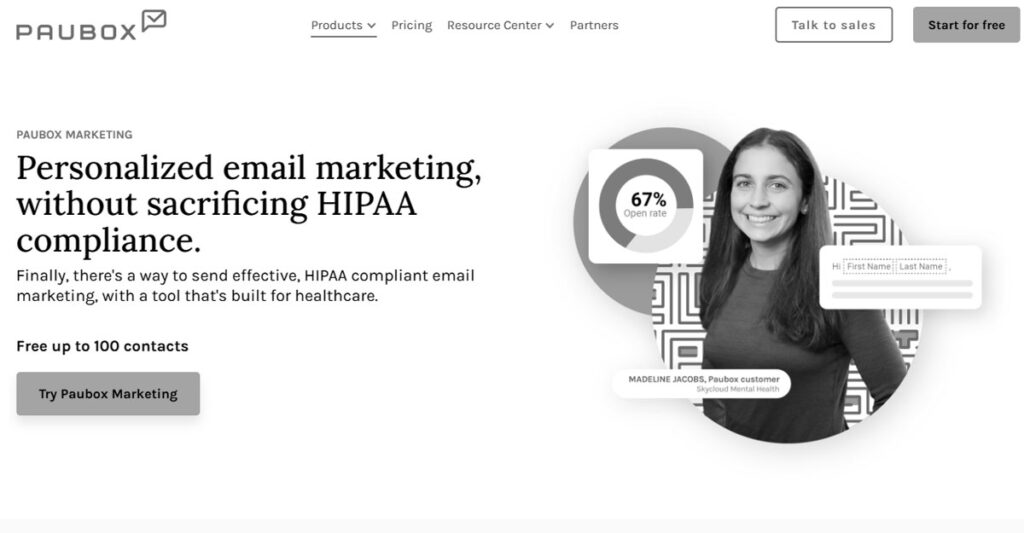Can a Single Social Media Post Wreck Patient Privacy and Violate HIPAA?
Key Takeaways
- HIPAA rules apply to everything you post online, not just medical records.
- You can engage on social media, but never post anything that could identify a patient.
- Even an innocent thank-you reply can violate HIPAA.
- Using the right tools and disclaimers protects you.
- Always train staff and monitor activity—yes, that includes interns.
- There are actual fines—we’re talking six figures—for HIPAA violations on social media.
- General health content? Great. Patient selfies? No.
- Never assume private messages are safe. They’re not unless you use a compliant platform.
Why Social Media Can Be a Total Trap for Healthcare Practices
Social media is free, fast, and freakishly easy. But if you’re in healthcare, it’s also a legal minefield. You’re out there posting wellness tips, showing off your clean waiting room, or maybe replying to patient reviews… but is that okay? Are you—without knowing—messing up patient privacy?
Short answer: yeah, probably.
Longer answer: you’re not alone.
Social media gives you attention. But HIPAA doesn’t care about your marketing strategy. It only cares about protected health information (PHI). And if even one post reveals something it shouldn’t? Boom—violation. It doesn’t matter if you didn’t mean to.
Here’s the thing: most people don’t know what counts as PHI in a digital world. And even fewer know what to avoid saying—or how to train their teams to not post something dumb.
What Actually Counts as PHI on Social Media?
People hear “patient privacy” and think that just means don’t say their name. But PHI includes way more than that. Here’s a list of things you absolutely cannot post—even if the patient is cool with it verbally.

18 HIPAA Identifiers You Must Keep Off Social Media
| Identifier | Why It’s a Problem |
| Name | Obvious. Identifies them. |
| Address (including ZIP) | Too specific. Traceable. |
| Dates (birth, visit) | Tells people when they came. |
| Phone Number | Personal contact info. |
| Email Address | Direct link to them. |
| Social Security Number | This should go without saying. |
| Medical Record Number | Total red flag. |
| Health Plan ID Number | Also very traceable. |
| Account Numbers | Can be tied to bills. |
| License Plate Numbers | Parking lot pics? Big nope. |
| Device Identifiers | Wearables, implants, etc. |
| URLs | Might link to private portals. |
| IP Address | Can track location. |
| Biometric IDs | Facial recognition? Risky. |
| Full Face Photos | No selfies, period. |
| Any Unique Identifier | If it singles someone out, no. |
If even one of these is in your post, you’re in violation.
Even implied info can get you in trouble.
Example:
Saying “We treated a young man from Boise who just beat cancer” seems fine, right? But in a small town, everyone knows who that is. That’s PHI.
How Easy Is It to Break HIPAA Rules Without Realizing? Way Too Easy
Let’s run through a few “harmless” scenarios:
- A nurse replies to a patient’s Facebook comment with “Glad your stitches are healing nicely!”
→ PHI. Violation. - A dentist posts a photo with a happy patient holding a “No Cavities” sign.
→ Even with no name shown, it’s a face + medical result. PHI. - A receptionist thanks a reviewer by saying, “It was a pleasure seeing you last week!”
→ Reveals treatment date. PHI.
You get the idea.
Social media is fast and casual. HIPAA is neither.
Here’s a better question:
Why is your front desk staff replying to comments at all? If they’re not trained in HIPAA social media policy, they shouldn’t even be holding the keys to the Facebook page.
Patient Privacy Rules Every Healthcare Practice Must Follow
Just so we all understand—HIPAA doesn’t care if it was an accident. Good intentions won’t save you from a fine, and “we didn’t know” isn’t a valid defense.
If your staff touches the practice’s Instagram, Facebook, TikTok, or even LinkedIn… they need to know and have this knowledge down cold.
So, What Are the Actual Rules?
Let me break them down into real-world do’s and don’ts. These aren’t just “nice to follow” tips. These are non-negotiables if you wanna stay HIPAA-compliant.
1. Always Get It In Writing
Before posting anything that even slightly hints at a real patient experience, you need signed, dated, written consent. Not a verbal yes. Not a thumbs-up emoji.
Written. Every. Time.
Even if someone begs you to post their before/after photo? Still needs paperwork. Every post is a liability unless you’ve got a legal green light.
2. Keep Replies Generic (Like, Really Generic)
Let’s say someone comments:
“Thanks Dr. Patel, my knee’s already feeling better!”
It’s tempting to say,
“So glad to hear it, see you in 6 weeks!”
Don’t.
You just confirmed they were a patient and hinted at a follow-up. Boom—HIPAA breach.
Safe reply example:
“We appreciate the feedback! Wishing you the best.”
Boring? Yeah. But safe.
3. Be Careful With Reviews
Public reviews are tricky. A patient can say what they want. But you can’t respond by confirming they’re a patient.
Don’t say:
“Thanks for trusting us with your dental care!”
Do say:
“Thanks for taking the time to leave a review!”
Also, don’t ask people to leave reviews with personal health details. That’s just setting yourself up.
4. No DM Diagnosing. Ever.
Someone messages your Facebook page:
“Can I take ibuprofen for this pain?”
Don’t. Answer.
Social media DMs are NOT HIPAA-compliant. You shouldn’t be giving medical advice or even discussing symptoms in a private message. Not unless it’s through a secure, encrypted platform designed for healthcare messaging.
Best move?
Tell them to call your office or use the patient portal.
5. Don’t Post That Photo—Yes, Even If Their Face Is Blurred
You might think, “Oh it’s fine, we blurred their face.” Or “It’s just the back of their head.”
Still no.
If anyone could identify them (even just themself), it’s still a violation. Don’t play the “but no one will notice” game. HIPAA will notice. Or someone else will… and then report you.
Disclaimers Aren’t a Magic Shield—But They Help

Every practice’s bio should say something like:
“Please do not share personal health info via social media. Call our office for medical questions.”
That doesn’t protect you if you slip up, but it does help when patients share too much.
Want a cheat sheet? Here’s a simple “Safe to Post?” checklist:
| Question | If Answer is “Yes” | Safe to Post? |
| Does it mention a patient name? | Yes | NO |
| Can someone be identified? | Yes | NO |
| Is there any date tied to care? | Yes | NO |
| Is it a general health tip? | Yes | Yes |
| Is there written consent? | Yes | Maybe |
Building a HIPAA-Compliant Social Media Strategy
A social media strategy isn’t just what you post. It’s also who posts it, how it’s approved, what tools you use, and what you do when something goes sideways. Most practices throw up an Instagram account and hand it off to the intern or someone “good with Canva.” That’s how you lose control—fast.
A HIPAA-compliant strategy? That’s something else entirely.
What Does a HIPAA-Compliant Social Media Strategy Actually Look Like?
Let’s break this down in plain English. Your practice needs:
- A written policy
- Trained humans
- A designated overseer
- Secure tools
- Monitoring systems
- Guardrails for content
- A response plan for when (not if) something goes wrong
That’s the real list.
Now here’s how it plays out.
1. Write a Policy. Like, On Actual Paper.
A real social media policy says:
- Who can post
- What can be posted
- What can never be posted
- How to get approval
- What happens if someone breaks the rules
Don’t just grab a template. Tailor it. Make sure everyone has a copy. Not just your social media person—everyone.
Interns, receptionists, volunteers, shadowing med students… if they can see a screen, they need that policy.
2. Train the Team (And Don’t Just Do It Once)

Most violations come from people who didn’t even know they were doing something wrong.
Example:
That new front desk hire who replied to a comment on Instagram with “It was great seeing you again today!” Ouch—HIPAA fine, incoming.
Training topics should include:
- What PHI is
- Examples of real violations
- What’s safe to say (and what’s not)
- How to flag a questionable post
- How to handle patient messages
Do a refresher every 6–12 months. You’ll be shocked what people forget.
3. Appoint a HIPAA “Watchdog”
This isn’t a side task. You need someone—preferably already part of your compliance team—who:
- Reviews every post before it goes live
- Monitors your practice’s online presence
- Tracks what’s being said about your practice
- Stays updated on HIPAA rule changes
- Handles incidents if they happen
Think of them as the bouncer at your social media party. They don’t let in anything sketchy.
4. Use Secure Tools—Not Just Free Stuff
You’re probably using tools like Hootsuite or Buffer. But are they HIPAA-compliant? Usually not.
Here’s what to look for in a tool:
| Feature | Why It Matters |
| End-to-end encryption | Keeps messages private |
| Business Associate Agreement | Legally binds the platform to HIPAA |
| Role-based access controls | Prevents untrained staff from posting |
| Audit logs | Lets you see who did what, and when |
| Secure storage of media/files | Protects content before posting |
If your tool doesn’t offer these, find one that does. Period.
5. Social Listening Isn’t Optional Anymore
You need to know what people are saying about your practice right now. Not to creep, but to catch risks before they explode.
You’re listening for:
- Misinfo that could spiral
- Patient complaints that need to be addressed (carefully)
- Reviews that could lead to HIPAA issues
- Posts that tag your practice in problematic ways
Don’t use this info to jump into comment wars. Use it to flag problems early.
6. Only Share Content That’s Safe—and Boring
No drama. No spotlight moments. Just:
- Health tips
- Office hours
- Reminders about flu season or screenings
- Public awareness weeks
- Team introductions (without names or PHI)
- “Did you know?” posts that don’t involve patients
Think of your content as educational, not personal.
7. Plan for Mistakes. You’ll Make One.
Eventually, someone will:
- Post without approval
- Accidentally reveal PHI
- Forget to blur something
- Say too much in a reply
You need a HIPAA social media incident plan that covers:
- Who to contact
- What to delete
- Who reports to HHS
- Whether to notify the patient
- What documentation to file
Don’t try to make that plan while in crisis. Set it up now, before things go sideways.
Your social strategy isn’t about going viral. It’s about being safe, building trust, and avoiding a $100,000 mistake.
Tools and Tactics to Stay HIPAA Safe Online
Let’s be real—no one wants to read a 45-page HIPAA manual before posting a tweet. That’s where tools come in. The right ones make it easier to avoid slip-ups, automate the boring parts, and help your practice look like it knows what it’s doing. But here’s the catch: not all tools are built for healthcare.
Just because it’s popular with influencers doesn’t mean it belongs anywhere near a patient privacy conversation. So let’s talk about what works, what doesn’t, and how to set things up right.
Which Tools Are HIPAA-Compliant for Social Media?

Most tools you’re already using? Probably not HIPAA-safe.
Here’s a breakdown of common tool categories and what you should check before using them.
| Tool Type | What to Check For | Good Examples |
| Social Media Management | BAA? Encrypted? Role controls? Audit trail? | Paubox Marketing, Sprout Secure |
| Messaging Platforms (DMs) | Never use native DMs. Use secure messaging instead. | Paubox Secure Messaging, Klara |
| Scheduling Tools | Can you approve content before it goes live? | Buffer for Business (with policy) |
| Review Platforms | Allows anonymous reviews? Can you filter PHI? | Birdeye, Podium (configured right) |
| Content Creation | Does it store photos safely? Can you watermark? | Canva (secure plan only), Doximity |
If you’re using anything that handles patient-related content, it better have a BAA (Business Associate Agreement) in place. If it doesn’t, it doesn’t belong in your workflow.
Posting From Phones? Here’s What to Know
Phones are dangerous. Why? Because:
- Staff might screenshot patient info.
- They might use personal apps to post.
- There’s no audit trail.
- Photos can end up in the wrong cloud account.
The fix?
- Use dedicated work phones—or better, don’t use phones at all for posting.
- Disable camera auto-backup.
- Don’t allow personal logins on business social media apps.
- Use apps that let you schedule and preview content, not just post on the fly.
Use Disclaimers Like a Shield
They don’t protect you from a violation you cause, but they do tell patients and followers what’s off-limits.
Here’s a copy-paste ready disclaimer:
“Please do not share personal health information on this page. Contact our office directly for medical questions.”
Put that:
- In your bio
- In comment replies (especially when a patient starts oversharing)
- In your automated DMs (yes, even on Instagram)
It’s not a legal forcefield—but it sets expectations.
Protect Content Before It Goes Live
There should always be a final review step. That means:
- No one posts solo. Every post gets a second set of eyes.
- Use watermarks or branding to discourage reposting without context.
- Review the photo, the caption, the hashtags—everything.
Some practices set up a “content approval flow” like this:
- Social media coordinator drafts post.
- HIPAA compliance officer reviews and flags anything risky.
- Marketing manager approves or revises.
- Post gets scheduled—never posted directly.
Is it more steps? Sure. But it prevents more problems than it causes.
Watch for “In the Wild” Risks
A lot of times, it’s not what you post. It’s what others post about you.
- Someone tags your office in a photo of their recovery?
- A parent shares their child’s visit and mentions your nurse?
- A former patient leaves a detailed review with medical info?
You’re not legally responsible for what people post on their own, but if you engage with it, you might be.
Rule of thumb: If they post PHI, don’t reply unless you very carefully avoid confirming it.
These tools and tactics don’t just make HIPAA compliance easier—they make it possible. You can’t wing it. You can’t guess. And you definitely can’t hope someone else is watching.
How to Share Content That Doesn’t Compromise Patient Privacy

You can absolutely be active online without getting in trouble. But you’ve gotta be smart about it. Sharing content that’s safe, engaging, and compliant isn’t impossible—it just takes a shift in how you think about content.
Don’t center your posts around people. Focus on value. That’s the key. If your goal is to help, not spotlight, you’re already on the right track.
What Kind of Content Is Safe to Post?
Here’s the stuff you can post with zero stress:
- General health tips (e.g., “3 ways to stay hydrated in summer”)
- Preventive care reminders (e.g., “Schedule your yearly screening”)
- Public health awareness dates (e.g., “It’s Heart Health Month!”)
- Behind-the-scenes updates (without staff or patients shown)
- Facility updates (e.g., “New equipment just installed”)
- Anonymous stats (e.g., “We’ve helped 150 patients quit smoking this year”)
- Staff spotlights (but no mention of patient interaction)
Avoid anything that centers around a specific patient interaction, unless you have rock-solid written consent. Even then, you better trust your own vetting process.
Educational Posts Work Better Anyway
Want more likes and shares? Post stuff that helps people understand their own health. This also positions your practice as trustworthy and informed, without you ever needing to touch PHI.
Examples:
| Topic | Caption Idea |
| Blood pressure management | “Here’s how to check it at home” |
| Flu season prep | “Should you get your shot now or wait?” |
| Seasonal allergies | “Why spring hits harder—and what helps” |
| Infant care | “When to call your pediatrician (and when not to)” |
| Dental hygiene | “The real reason flossing matters” |
These are topics people search for. They want to know this stuff. And you don’t need to talk about a single patient to teach them.
FAQs Can Be a Gold Mine (Just Don’t Personalize Them)
People love short answers to simple questions.
Try this:
Q: Can I get a flu shot if I’m pregnant?
A: Yes—actually, you should. It protects both of you.
Q: How often should I get a skin check?
A: Once a year, more if you’ve had issues before.
Now here’s the trap—don’t quote a patient’s question. Even if you leave their name out. If it’s something they sent you through social, it might count as PHI.
Instead, make the question general. “Here’s a question we hear a lot…” works way better.
Keep the Vibes Supportive, Not Specific
Wanna “build community”? That’s great. Just don’t build it around individual patient stories. Create space for:

- Health condition support (without personal stories)
- Resource sharing (like PDFs or guides)
- Event announcements (like wellness fairs)
- Anonymous polls (“What’s your biggest sleep struggle?”)
The second you highlight a person’s struggle—especially without their explicit signed consent—you’re back in dangerous territory.
When In Doubt, Leave It Out
This should be posted on the wall of every practice’s social media team:
If you have to ask “Is this okay to post?” it’s probably not.
There’s always a safer way to share something valuable. Always.
Potential Risks and Consequences of Getting HIPAA Wrong on Social Media
Here’s the part most people skim—and the part you probably shouldn’t. The risks for mishandling patient privacy on social media aren’t just “bad PR” or getting called out in the comments. We’re talking fines, lawsuits, lost jobs, and in some cases, criminal charges.
And yes, that includes stuff posted by accident.
And yes, that includes your intern’s post.
And yes, it can bankrupt a small practice.
Real Talk: What Happens If You Mess Up?
The Office for Civil Rights (OCR) is the federal agency that handles HIPAA violations. When they investigate, they don’t care if it was a mix-up, a misclick, or a moment of poor judgment. They want to know:
- Did you have a policy?
- Did you train your people?
- Did you fix it fast?
- Do you even know what you posted?
If the answers are “no,” “not really,” or “we thought it was fine,” you’re cooked.
Examples That Actually Happened (and Hurt)
Here are real cases where people blew it—and paid for it:
1. A nurse posted about a trauma patient on Facebook.
No name. No photo. But enough detail that people figured out who it was.
→ Fired. License suspended. Fined.
2. A dental practice replied to a Yelp review.
They just said “We’re sorry you had to wait so long for your filling.”
→ Confirmed the reviewer was a patient. Violation.
3. A staff member posted a happy selfie with a newborn patient.
Everyone thought it was cute. Except the parents, who didn’t give permission.
→ Major complaint. Lawsuit. Reputation destroyed.
This stuff happens. A lot.
How Big Are the Fines?
It depends on how bad the violation is—and whether your practice made an effort to prevent it.
Here’s how it usually breaks down:
| Level of Violation | Description | Penalty Range |
| Tier 1: Unaware, would’ve stopped it | You honestly didn’t know, and had safeguards | $100 – $50,000 per |
| Tier 2: Reasonable cause | You didn’t mean to, but could’ve known better | $1,000 – $50,000 per |
| Tier 3: Willful neglect (fixed) | You messed up badly, but at least fixed it fast | $10,000 – $50,000 per |
| Tier 4: Willful neglect (ignored) | You knew, didn’t care, didn’t fix it | $50,000 per + possible jail time |
That’s per violation. Not per post.
One bad thread with five bits of PHI? That’s five violations.
Don’t Forget Reputation Damage
HIPAA fines hurt. But losing public trust? That sticks longer.
Nobody wants to go to a doctor who got caught exposing patient privacy and info online. That kind of story spreads faster than your best wellness reel ever will.
Bad press → negative reviews → lower patient volume → insurance cuts ties → staff layoffs → real fallout.
You Can’t Blame the Platform
“But Facebook didn’t warn us.”
“But Instagram lets people comment that stuff.”
“But TikTok doesn’t have a HIPAA setting.”
None of that matters. You’re responsible for everything tied to your practice. If your logo’s on it, if your staff posted it, if it happened on your page—it’s your mess to clean up.
So, what’s the move?
- Respect patient privacy like it’s a loaded weapon.
- Assume everything you say online is public forever.
- Train your people like it’s part of their license exam.
- Have a plan in place for when things go wrong.
Because they will.
FAQs + Final Recap: Keeping Patient Privacy Safe on Social Media
You’ve made it this far, so let’s lock in what actually matters. Social media isn’t going anywhere. Neither is HIPAA. So you’ve got two choices: operate carefully within the rules—or eventually get burned by them.
Let’s break down the key points and answer some real questions healthcare teams usually ask when trying to stay compliant online and maintain patient privacy.
✅ Recap: What Your Practice Needs to Get Right
If you forget everything else, remember this list. Post it in your office if you have to.
HIPAA Social Media Compliance Checklist:
- [ ] Have a written social media policy
- [ ] Train all staff on PHI + social dos and don’ts
- [ ] Never post PHI without written consent
- [ ] Use tools that are HIPAA-compliant and secure
- [ ] Monitor comments, tags, and reviews regularly
- [ ] Avoid DMs for anything medical
- [ ] Always use disclaimers in bios and replies
- [ ] Review posts before they go live
- [ ] Assign one HIPAA “watchdog” to oversee all activity
- [ ] Have a response plan if a post goes wrong
That’s the basic structure. Doesn’t matter if you’re a solo practice or a multi-site clinic—this applies to everyone.
🧠 FAQs: What Healthcare Teams Ask All the Time
Q: What if a patient posts about us first? Can we reshare it?
A: No—not unless you’ve got written consent. Even if they tagged your office and gushed about you, resharing it makes you the source of the PHI.
Q: What if a staff member posts something personal about a patient on their own account?
A: That’s still a HIPAA violation if they’re acting in their role or learned the info through their job. You’re liable unless you’ve clearly trained and documented otherwise.
Q: Can we post before/after photos?
A: Only with signed authorization. Every single time. Verbal permission isn’t enough.
Q: Can we mention patient names if they leave reviews publicly?
A: Nope. Patients can say whatever they want. You cannot confirm or respond in a way that confirms they’re a patient.
Q: What if we use a private Instagram or Facebook group for our patients?
A: Still risky. Unless you’re using a HIPAA-compliant platform and you’ve got proper consent, you’re exposed. Most social media groups are not private enough to meet HIPAA standards.
Q: What if a post gets deleted right away after someone catches it? Is that still a violation?
A: Yes. If PHI was visible—even for a few minutes—it counts. And you may be required to report it.
Q: Is TikTok completely off-limits for healthcare?
A: Not off-limits—but very, very easy to mess up on. If you’re going to use it, lock down your policies and stick to general education. No patient stories, no treatment clips, nothing that could identify anyone.
Final Thought: HIPAA and Social Media Don’t Hate Each Other—But They Don’t Play Nice
You can still show up online. You can still educate, connect, even build a great brand.
But you have to do it with discipline.
Protecting patient privacy on social media isn’t about avoiding fun—it’s about avoiding fines, lawsuits, and lost trust. And if that means your posts are a little more boring? So be it. Trust is more powerful than trending.



